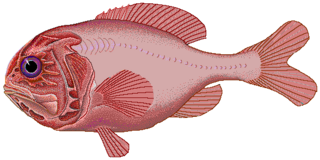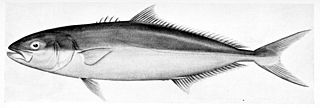
A tuna is a saltwater fish that belongs to the tribe Thunnini, a subgrouping of the Scombridae (mackerel) family. The Thunnini comprise 15 species across five genera, the sizes of which vary greatly, ranging from the bullet tuna up to the Atlantic bluefin tuna, which averages 2 m (6.6 ft) and is believed to live up to 50 years.

The bluefish is the only extant species of the family Pomatomidae. It is a marine pelagic fish found around the world in temperate and subtropical waters, except for the northern Pacific Ocean. Bluefish are known as tailor in Australia and New Zealand, elf and shad in South Africa. It is a popular gamefish and food fish.

The Eurasian carp or European carp, widely known as the common carp, is a widespread freshwater fish of eutrophic waters in lakes and large rivers in Europe and Asia. The native wild populations are considered vulnerable to extinction by the International Union for Conservation of Nature (IUCN), but the species has also been domesticated and introduced into environments worldwide, and is often considered a destructive invasive species, being included in the list of the world's 100 worst invasive species. It gives its name to the carp family, Cyprinidae.

Spearfishing is fishing using handheld elongated, sharp-pointed tools such as a spear, gig, or harpoon, to impaling the fish in the body. It was one of the earliest fishing techniques used by mankind, and has been deployed in artisanal fishing throughout the world for millennia. Early civilizations were familiar with the custom of spearing fish from rivers and streams using sharpened sticks.

A rain of animals is a rare meteorological phenomenon in which flightless animals fall from the sky. Such occurrences have been reported in many countries throughout history. One hypothesis is that tornadic waterspouts sometimes pick up creatures such as fish or frogs, and carry them for up to several miles. However, this aspect of the phenomenon has never been witnessed by scientists.

The orange roughy, also known as the red roughy, slimehead and deep sea perch, is a relatively large deep-sea fish belonging to the slimehead family (Trachichthyidae). The UK Marine Conservation Society has categorized orange roughy as "vulnerable to exploitation". It is found in 3 to 9 °C, deep waters of the Western Pacific Ocean, eastern Atlantic Ocean, Indo-Pacific, and in the eastern Pacific off Chile. The orange roughy is notable for its extraordinary lifespan, attaining over 200 years. It is important to commercial deep-trawl fisheries. The fish is a bright, brick-red color, fading to a yellowish-orange after death.

The yellowtail amberjack, yellowtail kingfish, hiramasa or great amberjack is a large fish found in the Southern Ocean. Although previously thought to be found in all oceans and seas, recent genetic analysis restricts S. lalandi proper to the Southern Hemisphere waters. However, they are found in Northern Hemisphere waters during certain times of the year. The fish was given its name by Monsieur de Lalande, a naturalist who first informed zoologist Achille Valenciennes of the existence of this species. His reason for the use of the word Seriola to name the fish is uncertain, but the second word lalandi was derived from his surname. These fish are now being farmed offshore in Maine.

The Australian ghostshark is a cartilaginous fish (Chondrichthyes) belonging to the subclass Holocephali (chimaera). Sharks, rays and skates are the other members of the cartilaginous fish group and are grouped under the subclass Elasmobranchii. Alternative names include elephant shark, makorepe, whitefish, plough-nose chimaera, or elephant fish. It is found off southern Australia, including Tasmania, and south of East Cape and Kaipara Harbour in New Zealand, at depths of 0–200 m (0–656 ft). Despite several of its names, it is not a shark, but a member of a closely related group.

A fish is an aquatic, craniate, gill-bearing animal that lacks limbs with digits. Included in this definition are the living hagfish, lampreys, and cartilaginous and bony fish as well as various extinct related groups. Approximately 95% of living fish species are ray-finned fish, belonging to the class Actinopterygii, with around 99% of those being teleosts.
Rudie Hermann Kuiter is an Australian underwater photographer, taxonomist, marine biologist and author of many identification guides to sea fishes. He has described new species of seahorses in the genus Hippocampus.

Marcusenius is a genus of the elephantfish group native to Africa. Its members are highly diverse in size, with the smallest species reaching less than 15 cm (6 in) and the largest more than 1 m (3.3 ft).

Battered sausages are a type of sausage found all across the United Kingdom, Ireland, Australia and New Zealand.
Lake Lenthall is a lake created by the Lenthalls Dam in Duckinwilla, Fraser Coast Region, Queensland, Australia. As a result of a 518 square kilometres (200 sq mi) catchment, it takes a short time in moderate rain events to fill Lake Lenthall to 100% capacity.
Sanko Harvest was a 32,502 DWT dry bulk carrier that sank off Esperance, Western Australia after striking a charted reef on 14 February 1991. The Korean-crewed Japanese-owned ship was 174 metres (571 ft) long and was carrying a cargo of 32,790 tonnes of phosphate fertilizer valued at A$8.9 million. Also on board were 677 tonnes of heavy bunker fuel and 40 tonnes of light diesel oil.
Hylopanchax is a genus of poeciliids native to the Congo River Basin and Ivindo River in Middle Africa.
Gerald Robert "Gerry" Allen is an American-born Australian ichthyologist. His career began in 1963, when he spent a semester at the University of Hawaii, where he also received a PhD in marine zoology in 1971. In 1972, Allen wrote his doctoral thesis on the systematics and biology of the anemone fish.
Incara multisquamatus is a species of fish in the family Butidae known from brackish waters along the coasts of India and Australia. This species grows to a length of 6 cm (2.4 in). This species is the only known member of its genus.
The Watson River is a river in Far North Queensland, Australia.
Lubbockichthys is a genus of ray-finned fish from the Indo-Pacific region which belongs to the subfamily Pseudoplesiopinae, part of the family Pseudochromidae, the dottybacks. The species in this genus have small cycloid scales throughout their lives; some of their head bones have a weakly honeycombed surface; and the parietal bone encloses the rear section of the supratemporal laterosensory canal.
Sphenomorphus multisquamatus is a species of skink found in Indonesia and Malaysia.










